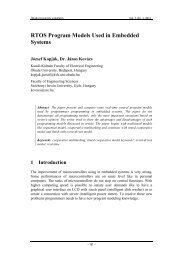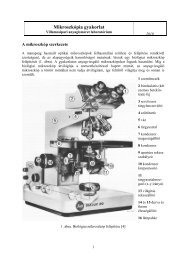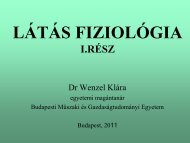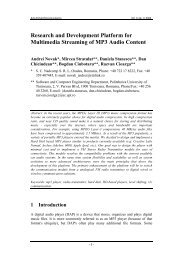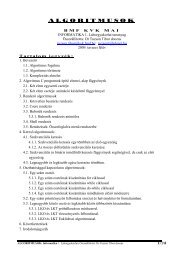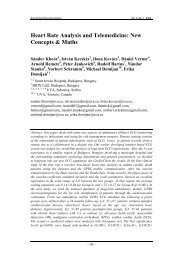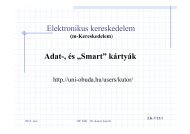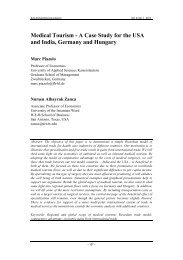Create successful ePaper yourself
Turn your PDF publications into a flip-book with our unique Google optimized e-Paper software.
Óbuda University e-Bullet<strong>in</strong> Vol. 3, No. 1, 2012<br />
<strong>The</strong> <strong>Use</strong> <strong>of</strong> <strong>Colour</strong> <strong>in</strong> <strong>Visual</strong> <strong>Poetry</strong><br />
Francis Edel<strong>in</strong>e<br />
Group µ, University <strong>of</strong> Liège, Belgium, e-mail: venus33@skynet.be<br />
Abstract : <strong>Poetry</strong> first existed as a strictly oral practice, and long before<br />
writ<strong>in</strong>g was <strong>in</strong>vented, let alone pr<strong>in</strong>t<strong>in</strong>g. It relied on the sound characteristics<br />
<strong>of</strong> each language. Now we are used to pr<strong>in</strong>t our poems on the whitest possible<br />
paper with the blackest possible <strong>in</strong>k, forgott<strong>in</strong>g that <strong>in</strong> so do<strong>in</strong>g we are us<strong>in</strong>g<br />
colours. In the middle <strong>of</strong> the twentieth century there appeared throughout the<br />
world a number <strong>of</strong> poets will<strong>in</strong>g to make use <strong>of</strong> the other possibilities <strong>of</strong> the<br />
visual signs: form and colour, <strong>in</strong> addition to the usual sound characteristics.<br />
<strong>The</strong>y were stimulated <strong>in</strong> do<strong>in</strong>g that by the progresses made <strong>in</strong> the pr<strong>in</strong>t<strong>in</strong>g<br />
techniques. Of course form was readily usable even <strong>in</strong> black pr<strong>in</strong>t, and there<br />
were many forerunners, even <strong>in</strong> the Greek antiquity. <strong>Colour</strong> began to be used<br />
<strong>in</strong> the Middle Ages, but to very little import. <strong>The</strong> possibilities <strong>of</strong> modern<br />
pr<strong>in</strong>t<strong>in</strong>g totally changed the situation, and the <strong>Visual</strong> Poets,- as they came to<br />
be named,- took full mesasure and advantage <strong>of</strong> these new means. In the<br />
present paper some <strong>of</strong> the significant achievements <strong>in</strong> this field will be<br />
presented and commented.<br />
Keywords: color, pattern, harmony<br />
1 Introduction<br />
<strong>Poetry</strong>, all over the world and across all civilizations, relies on the same<br />
characteristics <strong>of</strong> language : rhythm, pitch, duration, and dist<strong>in</strong>ctive features <strong>of</strong><br />
phonemes, <strong>in</strong> vowels as well as <strong>in</strong> consonants. This is obviously a survival <strong>of</strong> the<br />
time when poetry was <strong>in</strong>vented. Thus long before writ<strong>in</strong>g,- let alone pr<strong>in</strong>t<strong>in</strong>g,- was<br />
<strong>in</strong>vented. <strong>Poetry</strong> be<strong>in</strong>g strictly oral, colour could not be one <strong>of</strong> its dimensions.<br />
Now we are used to pr<strong>in</strong>t our poems with the blackest possible <strong>in</strong>k on the whitest<br />
possible paper, and that’s all. We simply forget that <strong>in</strong> do<strong>in</strong>g so we are us<strong>in</strong>g<br />
colour. <strong>The</strong> theory <strong>of</strong> codes tells us that a m<strong>in</strong>imum <strong>of</strong> two levels <strong>of</strong> any given<br />
dimension are required for the transmission <strong>of</strong> <strong>in</strong>formation. <strong>The</strong> first perhaps to<br />
realize that, was a Swiss poet named Eugen GOMRINGER, who gave as title to<br />
his major poem collection Worte s<strong>in</strong>d Schatten (1951-1968). By do<strong>in</strong>g that he<br />
forced us to forget, for a moment, the <strong>in</strong>dividual mean<strong>in</strong>g <strong>of</strong> the pr<strong>in</strong>ted words,<br />
– 285 –
Francis Edel<strong>in</strong>e <strong>The</strong> use <strong>of</strong> colour <strong>in</strong> visual poetry<br />
and to look at them as black surfaces on a white background: as shadows. Beyond<br />
the shock produced by this unusual <strong>in</strong>junction, a more subtle metaphor can be<br />
perceived : the words as signifiers are dist<strong>in</strong>ct from their signifieds, just as the<br />
image <strong>of</strong> an object is dist<strong>in</strong>ct from the object itself (cf. the well-known pa<strong>in</strong>t<strong>in</strong>g by<br />
Magritte This is not a pipe). We are rem<strong>in</strong>ded that <strong>in</strong> poetry we are not <strong>in</strong> the real<br />
world, we are us<strong>in</strong>g codes made <strong>of</strong> symbols, and symbols are, only and<br />
<strong>in</strong>escapably, <strong>in</strong>direct and remote ways <strong>of</strong> look<strong>in</strong>g at th<strong>in</strong>gs.<br />
In experimental psychology there is a well-known teaser show<strong>in</strong>g the names <strong>of</strong><br />
several colours pr<strong>in</strong>ted <strong>in</strong> a colour different from the one they are nam<strong>in</strong>g (Fig.1).<br />
One discovers that it is extremely difficult to tell rapidly <strong>in</strong> which colour each <strong>of</strong><br />
these words is pr<strong>in</strong>ted. This effect can only be neutralized if all the words are<br />
pr<strong>in</strong>ted <strong>in</strong> the same colour (preferably black but this is only a matter <strong>of</strong> cultural<br />
convention). When we are switched on the l<strong>in</strong>guistic code, it blocks (or<br />
considerably <strong>in</strong>hibits) the perception <strong>of</strong> images as such. <strong>The</strong> reverse is also true:<br />
the two codes are strongly <strong>in</strong>teract<strong>in</strong>g and tend to be mutually exclusive.<br />
<strong>Colour</strong>, as everyone knows, is a dimension <strong>of</strong> the visual sign, together with form<br />
and texture. <strong>Visual</strong> signs, on the other hand, are one <strong>of</strong> the two ma<strong>in</strong> media used<br />
for the transmission <strong>of</strong> language (the use <strong>of</strong> touch, while possible, rema<strong>in</strong>s <strong>in</strong><br />
practice restricted to the bl<strong>in</strong>d).<br />
In the middle <strong>of</strong> the twentieth Century, there appeared throughout the world a<br />
number <strong>of</strong> poets will<strong>in</strong>g to exploit more fully the other dimensions <strong>of</strong> the visual<br />
sign, namely form and colour. Of course form was already readily usable, even <strong>in</strong><br />
black pr<strong>in</strong>t. And there were many forerunners, <strong>in</strong>clud<strong>in</strong>g <strong>in</strong> the Greek antiquity,<br />
where rhopalic verses were <strong>in</strong> favour. In modern times however, shaped poems or<br />
calligrams have known a tremendous development.<br />
<strong>Colour</strong> has also been used <strong>in</strong> the past, but to a small extent and to very little<br />
import. One is hardly able to mention more than the use <strong>of</strong> red characters by<br />
Hraban MAUR (Fig.2) and a few other <strong>in</strong>stances. For these authors colour was<br />
only a way to underl<strong>in</strong>e or emphasize part <strong>of</strong> the content. This does not imply that<br />
poets and writers were not responsive to colour. One memorable <strong>in</strong>stance is the<br />
abundantly quoted l<strong>in</strong>es by Andrew MARVELL (<strong>The</strong> Garden, end <strong>of</strong> 6 th stanza):<br />
Annihilat<strong>in</strong>g all that’s made<br />
To a green thought <strong>in</strong> a green shade.<br />
Poets wrote about colour but did rarely use colour. <strong>The</strong> possibilities <strong>of</strong> modern<br />
pr<strong>in</strong>t<strong>in</strong>g totally changed the situation, and visual poets,- as they came to be called,-<br />
took the full measure <strong>of</strong> these new means, and were able to employ colour as an<br />
<strong>in</strong>tegral means <strong>of</strong> signification <strong>in</strong>stead <strong>of</strong> a mere ornament.<br />
– 286 –
Óbuda University e-Bullet<strong>in</strong> Vol. 3, No. 1, 2012<br />
BLEU ROUGE BRUN NOIR<br />
VERT JAUNE BLANC ROUGE<br />
ROSE BLEU VERT BLEU<br />
BRUN ROUGE NOIR JAUNE<br />
Fig.1 Fig.2<br />
In the present study I shall endeavour to review some <strong>of</strong> the most significant<br />
achievements <strong>in</strong> this field, presented <strong>in</strong> an order <strong>of</strong> <strong>in</strong>creas<strong>in</strong>g complexity. But <strong>in</strong><br />
the first place I want to apologize because, due to the lack <strong>of</strong> space, I’ll be<br />
expla<strong>in</strong><strong>in</strong>g the works, thus depriv<strong>in</strong>g the reader <strong>of</strong> the pleasure to discover by<br />
himself the subtleties and the craftsmanship <strong>of</strong> the artists.<br />
2 Survey <strong>of</strong> the Corpus<br />
2.1 Tibor Papp<br />
I am very glad to open this short display with a Hungarian poet: Tibor PAPP.<br />
Tibor lives part-time <strong>in</strong> Paris and part-time <strong>in</strong> Budapest. We have been close<br />
friends s<strong>in</strong>ce 1956, when he flew away from Hungary and landed <strong>in</strong> my city <strong>of</strong><br />
Liège, without know<strong>in</strong>g a s<strong>in</strong>gle word <strong>of</strong> French. But s<strong>in</strong>ce, he has become a<br />
prom<strong>in</strong>ent member <strong>of</strong> the well-known French circle POLYPHONIX, and<br />
produced a variety <strong>of</strong> sound and visual poetry mak<strong>in</strong>g use <strong>of</strong> all the technical<br />
devices that are available today.<br />
– 287 –
Francis Edel<strong>in</strong>e <strong>The</strong> use <strong>of</strong> colour <strong>in</strong> visual poetry<br />
Here is a poem named “evanescence” (Fig.3), show<strong>in</strong>g, with the help <strong>of</strong> colour,<br />
the fleet<strong>in</strong>g aspect <strong>of</strong> words and <strong>of</strong> reality, appear<strong>in</strong>g, disappear<strong>in</strong>g, <strong>in</strong>duc<strong>in</strong>g us <strong>in</strong><br />
error with fallacious similarities.<br />
2.2 Pierre and Ilse Garnier<br />
Fig.3<br />
By the several publications and reviews they have produced, Pierre and Ilse<br />
GARNIER have been among the pr<strong>in</strong>cipal <strong>in</strong>troducers <strong>of</strong> concretism on the<br />
European cont<strong>in</strong>ent. But their personal creation is also very important, even if<br />
colour as such is only, <strong>in</strong> their output, marg<strong>in</strong>ally present.<br />
Ilse, the German wife <strong>of</strong> Pierre, has taken a fundamental step <strong>in</strong> decid<strong>in</strong>g to<br />
compose most <strong>of</strong> her major portfolios on grey paper (Canson mi-te<strong>in</strong>te). So,<br />
whereas <strong>in</strong> ord<strong>in</strong>ary practice one has only one degree <strong>of</strong> freedom (black on white,<br />
or white on black), she has two, the <strong>in</strong>termediate grey allow<strong>in</strong>g simultaneous<br />
white and black pr<strong>in</strong>ted words. I consider this discovery as fundamental from the<br />
po<strong>in</strong>t <strong>of</strong> view <strong>of</strong> <strong>in</strong>formation theory. <strong>The</strong> first example (Fig.4) is taken from a<br />
portfolio whose title is, appropriately, ORPHEUS im Tal der Schatten (ORPHEUS<br />
<strong>in</strong> the valley <strong>of</strong> Shadows). <strong>The</strong> first sheet shows the hero stepp<strong>in</strong>g over the<br />
threshold <strong>of</strong> Hell. <strong>The</strong> two further examples are extracted from the Conte de la<br />
forêt pr<strong>of</strong>onde (Tale <strong>of</strong> the deep forest).<br />
– 288 –
Óbuda University e-Bullet<strong>in</strong> Vol. 3, No. 1, 2012<br />
Fig.4<br />
From Pierre I am always pleased to show two delightful poems, well express<strong>in</strong>g<br />
the ecological concerns <strong>of</strong> their author (Fig.5). <strong>The</strong> first presents the five vowels<br />
as colourful twitter<strong>in</strong>g birds, while the second is probably the most synthetic<br />
representation <strong>of</strong> a butterfly one can imag<strong>in</strong>e, but still ma<strong>in</strong>ta<strong>in</strong><strong>in</strong>g a full and<br />
conv<strong>in</strong>c<strong>in</strong>g visual evidence.<br />
Fig.5<br />
– 289 –
Francis Edel<strong>in</strong>e <strong>The</strong> use <strong>of</strong> colour <strong>in</strong> visual poetry<br />
2.3 Timm Ulrichs<br />
In Germany was created and developed s<strong>in</strong>ce 1960, under the name <strong>of</strong> Totalkunst,<br />
a very orig<strong>in</strong>al k<strong>in</strong>d <strong>of</strong> artworks. Its founder and sole promoter is the Totalkünstler<br />
Timm ULRICHS. I won’t describe <strong>in</strong> any detail what Totalkunst is about: suffice<br />
it to say that the word total is fully justified, and to refer those <strong>in</strong>terested to the<br />
selected bibliography that I have provided. Among Timm’s works <strong>in</strong> which colour<br />
plays a significant role, I have selected the follow<strong>in</strong>g two (Fig.6). All these works<br />
are surpris<strong>in</strong>gly simple and self-explanatory, warrant<strong>in</strong>g their strong effect.<br />
2.4 Thomas A. Clark<br />
Fig.6<br />
Thomas Alexander Clark is a Scottish poet, who started writ<strong>in</strong>g shortly after the<br />
beg<strong>in</strong>n<strong>in</strong>gs <strong>of</strong> Concrete <strong>Poetry</strong>. He soon created his own hand-press to produce his<br />
poems (Moschatel Press), always to the highest pr<strong>of</strong>essional standards. His<br />
personal <strong>in</strong>terest <strong>in</strong> colour is already apparent <strong>in</strong> one <strong>of</strong> his earliest visual poems,<br />
stat<strong>in</strong>g A hunger for green / A thirst for blue. But I’ll be show<strong>in</strong>g you the<br />
delightful and efficient folder he sent to his friends last December, as a New-<br />
Year’s present (Fig.7). <strong>The</strong> title, Unfold<strong>in</strong>g brightness, plays on the word fold. <strong>The</strong><br />
poet had already been us<strong>in</strong>g the word unfold<strong>in</strong>g metaphorically elsewhere, <strong>in</strong><br />
connection with sheepfolds. This time, as one unfolds the folder, the gesture<br />
displays at the same time the full and bright sunlight, as fit for a solstice, <strong>in</strong> the<br />
form <strong>of</strong> three sheets <strong>of</strong> a bright yellow paper. Brightness comes out and <strong>in</strong>creases<br />
as one cont<strong>in</strong>ues unfold<strong>in</strong>g the sheets, just as the sun will do <strong>in</strong> the follow<strong>in</strong>g<br />
months. Be<strong>in</strong>g himself a pr<strong>in</strong>ter, and used to bookmak<strong>in</strong>g, he spontaneously<br />
<strong>in</strong>corporated the gesture <strong>in</strong> this work, whose efficiency also comes from its brevity<br />
(two words) and extreme formal simplicity.<br />
– 290 –
Óbuda University e-Bullet<strong>in</strong> Vol. 3, No. 1, 2012<br />
2.5 Ian Hamilton F<strong>in</strong>lay<br />
Fig.7<br />
Apart from his celebrated garden, this world-famous Scottish artist published<br />
many poem-pr<strong>in</strong>ts, among which several have colour as an essential component.<br />
<strong>The</strong> first I’ll describe is the grammatical fusion <strong>of</strong> ME and YOU <strong>in</strong>to US, which is<br />
paralleled by the mixture <strong>of</strong> two colours (Fig.8).<br />
My second example is a visual poem <strong>of</strong> the category known as semiotic poems<br />
(Fig.9). <strong>The</strong>y comprise two parts. In the largest one a small number <strong>of</strong> visual signs<br />
(ideally only two) are displayed <strong>in</strong> a mean<strong>in</strong>gful arrangement. In a corner <strong>of</strong> the<br />
work one f<strong>in</strong>ds a lexical key propos<strong>in</strong>g the translation <strong>of</strong> the selected signs <strong>in</strong>to<br />
concepts or words. In my example the horizontal blue l<strong>in</strong>e suggests the sea and the<br />
oblique brown ones the hill slopes.<br />
Fig.8 Fig.9<br />
– 291 –
Francis Edel<strong>in</strong>e <strong>The</strong> use <strong>of</strong> colour <strong>in</strong> visual poetry<br />
2.6 Francis Edel<strong>in</strong>e<br />
If I am allowed to quote one <strong>of</strong> my own works, here is a construction around the<br />
vowel U (Fig.10). If you rotate the letter four times by 90°, giv<strong>in</strong>g to each stage a<br />
different colour, you obta<strong>in</strong> a perfectly symmetric figure, apparently made <strong>of</strong> a<br />
circle <strong>in</strong>scribed <strong>in</strong> a square. This is also the basic structure <strong>of</strong> a tantric Mandala.<br />
<strong>The</strong> orig<strong>in</strong>al work is made <strong>of</strong> four transparent sheets <strong>of</strong> paper, carefully aligned,<br />
each one with the letter U pr<strong>in</strong>ted <strong>in</strong> a s<strong>in</strong>gle colour. <strong>The</strong> four selected colours<br />
(yellow, blue, green and red) are the traditional colours used <strong>in</strong> Mandalas.<br />
2.7 Arnaldo Antunes<br />
Fig.10<br />
ANTUNES is a Brazilian poet, younger and clearly <strong>in</strong>fluenced by de CAMPOS :<br />
<strong>in</strong> his circular poem Chromosome (Fig.11) he uses the type face created by the<br />
latter. He cleverly takes advantage <strong>of</strong> the close resemblance (<strong>in</strong> Portuguese) <strong>of</strong><br />
words like cromossomo, como, cosmos, somo and emphasizes the only outly<strong>in</strong>g<br />
letter R by pr<strong>in</strong>t<strong>in</strong>g it <strong>in</strong> red. This rem<strong>in</strong>ds us <strong>of</strong> the greek root χρωμα (colour) and<br />
σωμα (body), and also (for those who know the fact!) that chromosomes were<br />
discovered and received their name (<strong>in</strong> 1888) because <strong>of</strong> their aff<strong>in</strong>ity for certa<strong>in</strong><br />
dyes, among which the red dye fuchs<strong>in</strong>. <strong>The</strong> circular form <strong>of</strong> course evokes the<br />
liv<strong>in</strong>g cell and the endless cha<strong>in</strong> <strong>of</strong> life.<br />
– 292 –
Óbuda University e-Bullet<strong>in</strong> Vol. 3, No. 1, 2012<br />
2.8 David Bell<strong>in</strong>gham<br />
Fig.11<br />
Another Scottish poet is David Bell<strong>in</strong>gham, <strong>of</strong> whom I’ll show a group <strong>of</strong> poems I<br />
have gathered under the French title Agrumes (Citrus fruits) (Fig.12).<br />
A poet <strong>in</strong>evitably melds words and colours, just as a visual artist fuses colours and<br />
shapes. This is why David Bell<strong>in</strong>gham, be<strong>in</strong>g both poet and visual artist, is so able<br />
to present us with these three expressions <strong>of</strong> his deep reflection on the subject.<br />
Figurative form places limitations on the artist’s palette <strong>of</strong> colours. And one <strong>of</strong> the<br />
major battles for abstract artists has been the dissociation <strong>of</strong> form and colour,<br />
which, nevertheless, still cl<strong>in</strong>g stubbornly one to the other, all the more so s<strong>in</strong>ce<br />
they are bound together by language.<br />
All developed languages have around ten words for specific colours, <strong>of</strong> which<br />
yellow and green are two. Other colours, outside this category, can be referred to<br />
only by reference to an object that is <strong>of</strong> that colour, so that f<strong>in</strong>ally the mean<strong>in</strong>g <strong>of</strong><br />
the name <strong>of</strong> this object will expand to <strong>in</strong>clude the colour as well e.g. violet, lilac,<br />
fuchsia and, <strong>in</strong> particular, orange. <strong>The</strong> short poem lemon yellow lemon eloquently<br />
illustrates this characteristic <strong>of</strong> the vocabulary <strong>of</strong> colour. <strong>The</strong> orange is the only<br />
one <strong>of</strong> the citrus fruits to have developed <strong>in</strong> this way. Whereas it takes three words<br />
to describe a lemon or a lime – the name <strong>of</strong> the colour placed <strong>in</strong>side the encircl<strong>in</strong>g<br />
boundary <strong>of</strong> the repeated name <strong>of</strong> the fruit – it takes only two words to describe an<br />
orange, s<strong>in</strong>ce the names <strong>of</strong> the fruit and the colour are one and the same.<br />
– 293 –
Francis Edel<strong>in</strong>e <strong>The</strong> use <strong>of</strong> colour <strong>in</strong> visual poetry<br />
Fig.12<br />
In the ma<strong>in</strong> image, the eye is first drawn to the three blocks <strong>of</strong> pure colour. <strong>The</strong><br />
lemon and the lime are identifiable by their shape, and are dist<strong>in</strong>guishable one<br />
from the other by their colour and size. <strong>The</strong> unique roundness <strong>of</strong> the orange is not<br />
what enables us to identify it : only the presence <strong>of</strong> the other two fruits steers our<br />
<strong>in</strong>terpretation towards the paradigm <strong>of</strong> citrus fruit, which is then superimposed by<br />
the paradigm <strong>of</strong> colours. <strong>The</strong>n the respective size <strong>of</strong> the three fruits <strong>in</strong> turn leads to<br />
a third paradigm, that <strong>of</strong> the heavenly bodies, which, with three words, are<br />
<strong>in</strong>scribed on the background <strong>of</strong> undef<strong>in</strong>ed cosmic darkness.<br />
citrus f<strong>in</strong>ials adds a humorous, ephemeral dimension to the theme. <strong>The</strong> shape <strong>of</strong><br />
the fruit, after the juice has been squeezed out <strong>of</strong> it and enjoyed, comb<strong>in</strong>ed with<br />
the waterpro<strong>of</strong> firmness characteristic <strong>of</strong> its sk<strong>in</strong>, allow it to be made <strong>in</strong>to coloured<br />
f<strong>in</strong>ials, just right for temper<strong>in</strong>g (if only briefly) the ferocity <strong>of</strong> the wrought iron<br />
spears.<br />
2.9 Arrigo Lora-Tot<strong>in</strong>o<br />
Arrigo LORA-TOTINO is an Italian poet liv<strong>in</strong>g <strong>in</strong> Tor<strong>in</strong>o. S<strong>in</strong>ce more than fifty<br />
years he has produced an immense amount <strong>of</strong> sound and visual poems, as well as<br />
gymnic performances. Dur<strong>in</strong>g several periods (notably <strong>in</strong> 1977 and 1978) he was<br />
specially <strong>in</strong>terested <strong>in</strong> colour and used it <strong>in</strong> a very personal way. He thought silkpr<strong>in</strong>t<strong>in</strong>g<br />
was the best way to obta<strong>in</strong> vivid, strongly saturated colours, even on<br />
black paper. His titles are evocative : Crom<strong>of</strong>onemi iridescenti and Incandescenze.<br />
One <strong>of</strong> the most fasc<strong>in</strong>at<strong>in</strong>g properties <strong>of</strong> colour is that one can easily use it for socalled<br />
OP-effects: sc<strong>in</strong>tillation, dazzl<strong>in</strong>g, iridescence etc. LORA-TOTINO is a<br />
skilful user <strong>of</strong> these possibilities. From the first portfolio I extract sheets n°1 and 2<br />
(Fig.13), where he managed to obta<strong>in</strong> pleasant optical effects <strong>of</strong> sc<strong>in</strong>tillation and<br />
lustre by plac<strong>in</strong>g contrast<strong>in</strong>g colours close together, <strong>in</strong> addition to the po<strong>in</strong>tillistic<br />
effect produced by the typographical characters. As most <strong>of</strong> his fellow artists <strong>of</strong><br />
the time, he used the FUTURA font. <strong>The</strong> second portfolio conta<strong>in</strong>s five large silk-<br />
– 294 –
Óbuda University e-Bullet<strong>in</strong> Vol. 3, No. 1, 2012<br />
pr<strong>in</strong>ts (51x61) under the subtitle 5 it<strong>in</strong>erari litoranei (Fig.14). <strong>The</strong>y portray the<br />
colour atmosphere, the fleet<strong>in</strong>g and sc<strong>in</strong>tillat<strong>in</strong>g impression <strong>of</strong> light at different<br />
hours <strong>of</strong> the day (dawn, morn<strong>in</strong>g, noon, afternoon, even<strong>in</strong>g), on the Arno estuary.<br />
Of course the <strong>in</strong>terest <strong>of</strong> such visual poems is not limited to their use <strong>of</strong> colour: it<br />
is enhanced by the sonority <strong>of</strong> the words: fluire – affluire – confluire etc.<br />
Fig.13<br />
Fig.14<br />
– 295 –
Francis Edel<strong>in</strong>e <strong>The</strong> use <strong>of</strong> colour <strong>in</strong> visual poetry<br />
2.10 Augusto de Campos<br />
<strong>The</strong> Brazilian poet Augusto de CAMPOS, together with his brother Haroldo, and<br />
<strong>in</strong> conjunction with the Swiss poet Eugen GOMRINGER, created <strong>in</strong> 1955 the<br />
movement <strong>of</strong> Concrete <strong>Poetry</strong>, soon to become an active <strong>in</strong>ternational community<br />
<strong>of</strong> poets. Augusto de CAMPOS is famous for his <strong>in</strong>ventiveness, and s<strong>in</strong>ce the<br />
beg<strong>in</strong>n<strong>in</strong>gs he never ceased to explore new techniques: light bulbs, pop-up poems,<br />
video-poems, holograms etc.<br />
A great many <strong>of</strong> his creations rely on colour.<br />
Sem saida (Without exit) has to be sequentially projected on a screen: what I am<br />
show<strong>in</strong>g here is the f<strong>in</strong>al result (Fig.15). First appears for <strong>in</strong>stance a yellow<br />
sentence, written along an undulat<strong>in</strong>g l<strong>in</strong>e. <strong>The</strong>n comes a second phrase, <strong>in</strong><br />
another colour, also zig-zagg<strong>in</strong>g on the screen, and cross<strong>in</strong>g the first. A total <strong>of</strong> 7<br />
sentences appear successively, f<strong>in</strong>ally cover<strong>in</strong>g the screen and compos<strong>in</strong>g a full<br />
square and a complete poem. Each l<strong>in</strong>e is constra<strong>in</strong>ed <strong>in</strong> the square, a space from<br />
which the poet cannot escape, as the text repeats. <strong>The</strong> text also has a double<br />
mean<strong>in</strong>g, and is rem<strong>in</strong>iscent <strong>of</strong> the dictatorship period that the Brazilians had to<br />
suffer <strong>in</strong> 1964. In the f<strong>in</strong>al result, only colour allows to discover and to read the<br />
<strong>in</strong>dividual sentences.<br />
Fig.15 Fig.16<br />
Lygia f<strong>in</strong>gers proposes a more complex process (Fig.16). Besides be<strong>in</strong>g a poet, Augusto de<br />
CAMPOS is also a musical critic who was much admir<strong>in</strong>g Anton von WEBERN. In 1909,<br />
Schoenberg conceived the Klangfarbemelodie (Tone-<strong>Colour</strong> Melody), a new method<br />
for compos<strong>in</strong>g music. <strong>The</strong> idea was to replace, or to complement, the usual tone-scale with<br />
a series <strong>of</strong> timbres. <strong>The</strong> timbre is the specific frequency spectrum <strong>of</strong> each musical<br />
<strong>in</strong>strument, that dimension <strong>of</strong> sound by which one immediately dist<strong>in</strong>guishes a guitar from<br />
a piano, or an organ from a flute. In German, timbre is named Klangfarbe, which is <strong>of</strong><br />
course a metaphor translat<strong>in</strong>g sound <strong>in</strong>to colour. Webern, a past-student <strong>of</strong> Schoenberg,<br />
developed and used this new mode <strong>of</strong> composition. In this musical style the composer<br />
– 296 –
Óbuda University e-Bullet<strong>in</strong> Vol. 3, No. 1, 2012<br />
selects several different <strong>in</strong>struments and has them to play only specified notes. But de<br />
CAMPOS took the colour metaphor at face value. To that effect he reta<strong>in</strong>ed the first bars <strong>of</strong><br />
Quartette opus 22, <strong>in</strong> which 5 <strong>in</strong>struments are perform<strong>in</strong>g (a viol<strong>in</strong>, a saxophone, a clar<strong>in</strong>et<br />
and the two hands <strong>of</strong> a piano). To each tone was attributed one colour, and with these<br />
simple data a short story was built. Lygia is the name <strong>of</strong> the poet’s wife, pr<strong>in</strong>ted <strong>in</strong> a deep<br />
red. She was a typist (hence the f<strong>in</strong>gers). From top to bottom you can follow her under<br />
different guises and wordplays, as well as her fel<strong>in</strong>e aspect, and the name <strong>of</strong> a second<br />
woman. Claus CLÜVER (1981) has given a clear and detailed description <strong>of</strong> the method.<br />
Here I’d like to open an aside. Many attempts have been made to establish a<br />
parallel between colour and sound, on the ground that both are cont<strong>in</strong>uums<br />
governed by frequencies. <strong>The</strong> fallacy <strong>of</strong> this conception can easily be<br />
demonstrated (see f.i. L<strong>in</strong>ares, 2008). But the most salient remark is that these<br />
theories, <strong>in</strong> correlat<strong>in</strong>g the frequencies <strong>of</strong> both doma<strong>in</strong>s, consider that each colour<br />
corresponds to a sound pitch, i.e. to its height, whereas the notion <strong>of</strong> Tone-<strong>Colour</strong>,<br />
or Klangfarbe, or Timbre, the only musical parameter to be spontaneously<br />
associated with colour, has little or noth<strong>in</strong>g to do with pitch… A sound <strong>of</strong> the<br />
same pitch can be produced by a variety <strong>of</strong> <strong>in</strong>struments, which nevertheless<br />
clearly reta<strong>in</strong> their dist<strong>in</strong>ctive “colour” and can easily be identified. <strong>The</strong> poem by<br />
de CAMPOS <strong>in</strong> no way <strong>in</strong>dulges <strong>in</strong> such fallacies.<br />
2.11 He<strong>in</strong>z Gappmayr<br />
<strong>The</strong> visual poems by the late He<strong>in</strong>z GAPPMAYR (Austria) are quite difficult to<br />
describe and to comment, not because <strong>of</strong> their visual complexity but because <strong>of</strong><br />
their philosophical turn. Several <strong>of</strong> them are about colour, and a complete<br />
exhibition has been devoted to this subject <strong>in</strong> Innsbruck <strong>in</strong> 2000 under the general<br />
title Text Farbe Raum. On this occasion the author published a short essay about<br />
his conception <strong>of</strong> colour <strong>in</strong> visual poetry. <strong>The</strong> pr<strong>in</strong>cipal theme <strong>of</strong> his poetry is time<br />
and space, and colour is a later addition to the ma<strong>in</strong>stream <strong>of</strong> his reflections. He is<br />
<strong>in</strong>terested <strong>in</strong> questions such as the mean<strong>in</strong>g <strong>of</strong> colour, the relationship between<br />
colour and language, and the k<strong>in</strong>d <strong>of</strong> space created by colour (Fig.17). F<strong>in</strong>ally he<br />
questions the nature <strong>of</strong> the colour that a subject can form <strong>in</strong> his imag<strong>in</strong>ation after<br />
be<strong>in</strong>g evoked by a word, as compared to the same colour perceived directly. This<br />
latter problem had been nicely put <strong>in</strong> the teaser previously shown (Fig.1) : the<br />
name <strong>of</strong> a colour supersedes the colour itself!<br />
– 297 –
Francis Edel<strong>in</strong>e <strong>The</strong> use <strong>of</strong> colour <strong>in</strong> visual poetry<br />
Conclusions<br />
Fig.17<br />
Many more examples could <strong>of</strong> course have been shown, but they all would have<br />
concurred to demonstrate the <strong>in</strong>terest <strong>of</strong> colour as a means to <strong>in</strong>crease the<br />
efficiency <strong>of</strong> poetry. <strong>The</strong> use <strong>of</strong> colour has procured poets with an additional<br />
channel <strong>of</strong> mean<strong>in</strong>g, simultaneous to the l<strong>in</strong>guistic one and conveyed directly by<br />
colour without the help <strong>of</strong> words. In these <strong>in</strong>stances both channels reta<strong>in</strong> their full<br />
capacity. As the same units function simultaneously at both levels, and not as if<br />
the two codes were simply juxtaposed, one may call them <strong>in</strong>tersemiotic.<br />
Sometimes the colour contrasts play strictly <strong>in</strong>side the poem, sometimes their<br />
mean<strong>in</strong>g plays on an external reference.<br />
However one must not forget that, s<strong>in</strong>ce the advent <strong>of</strong> the Concrete <strong>Poetry</strong><br />
movement, an open<strong>in</strong>g has also been made towards space and movement, so that<br />
the complex contemporary works are a comb<strong>in</strong>ation <strong>of</strong> several semiotic<br />
dimensions : language, form, colour, space and movement.<br />
References<br />
[1] Y. Abrioux, IAN HAMILTON FINLAY - A visual primer, Reaktion, Ed<strong>in</strong>burgh:<br />
1985.<br />
[2] M. Band<strong>in</strong>i, Lora-Tot<strong>in</strong>o, Arrigo - Il teatro della parola, Regione Piemonte,<br />
Tor<strong>in</strong>o: 1996.<br />
[3] C. Clüver. "Klangfarbenmelodie <strong>in</strong> Polychromatic Poems: A. von Webern and<br />
A. de Campos,"Comparative Litérature Studies, vol. 18 n°3, 1981, pp.<br />
386-398.<br />
[4] A. de Campos, POETEMOINS - anthologie, Les presses du réel, Dijon: 2011.<br />
– 298 –
Óbuda University e-Bullet<strong>in</strong> Vol. 3, No. 1, 2012<br />
[5] H. Gappmayr, Text Farbe Raum, Folio Verlag, Vienna - Bozen: 1990.<br />
[6] I. Garnier, Jazz pour les yeux - anthologie de poésie spatiale, L'herbe qui<br />
tremble, Paris: 2011.<br />
[7] P. Garnier, Oeuvres poétiques 2 - 1968-1988, Ed. des Vanneaux, Montreuil-<br />
sur-Brêche: 2009.<br />
[8] E. Gomr<strong>in</strong>ger, Worte s<strong>in</strong>d Schatten, Rowohlt, 1964.<br />
[9] M. L<strong>in</strong>ares. "Farb- und Tonsysteme: Analogien und Differenzen,"Phänomen<br />
Farbe, vol. nr 2, 2008, pp. 30-36.<br />
[10] T. Ulrichs, Timm Ulrichs - Retrospective 1960-1975, Kunstvere<strong>in</strong><br />
Braunschweig, Braunschweig: 1976.<br />
– 299 –




